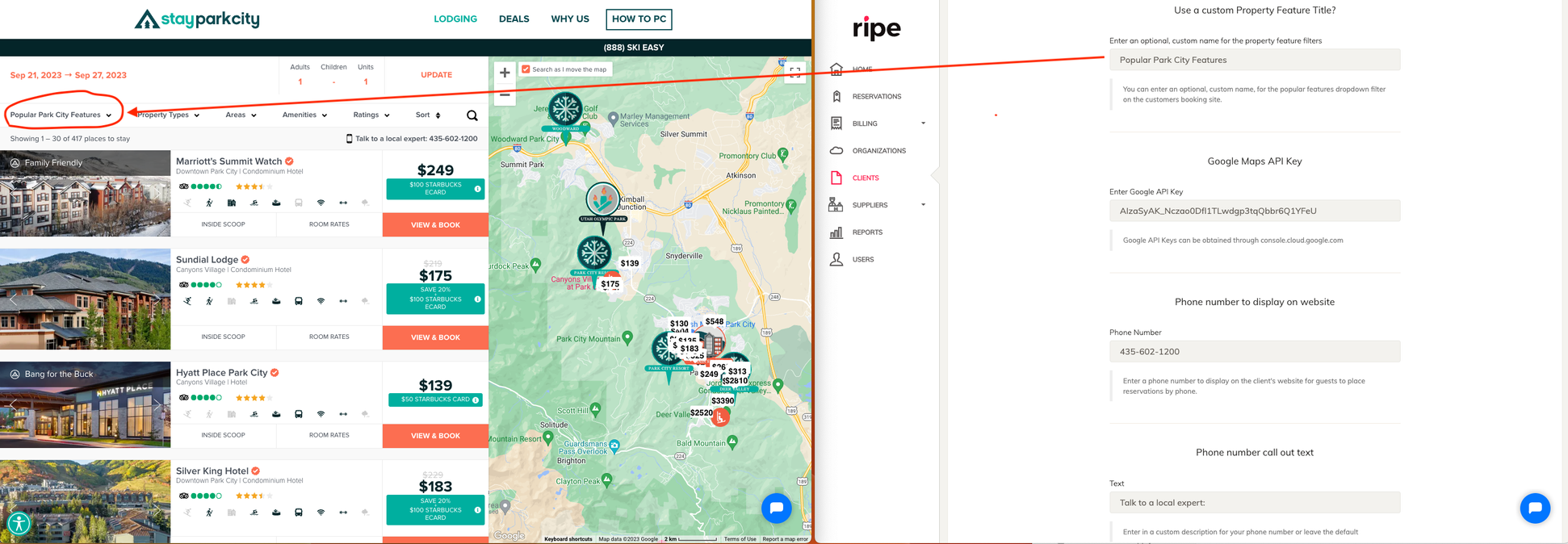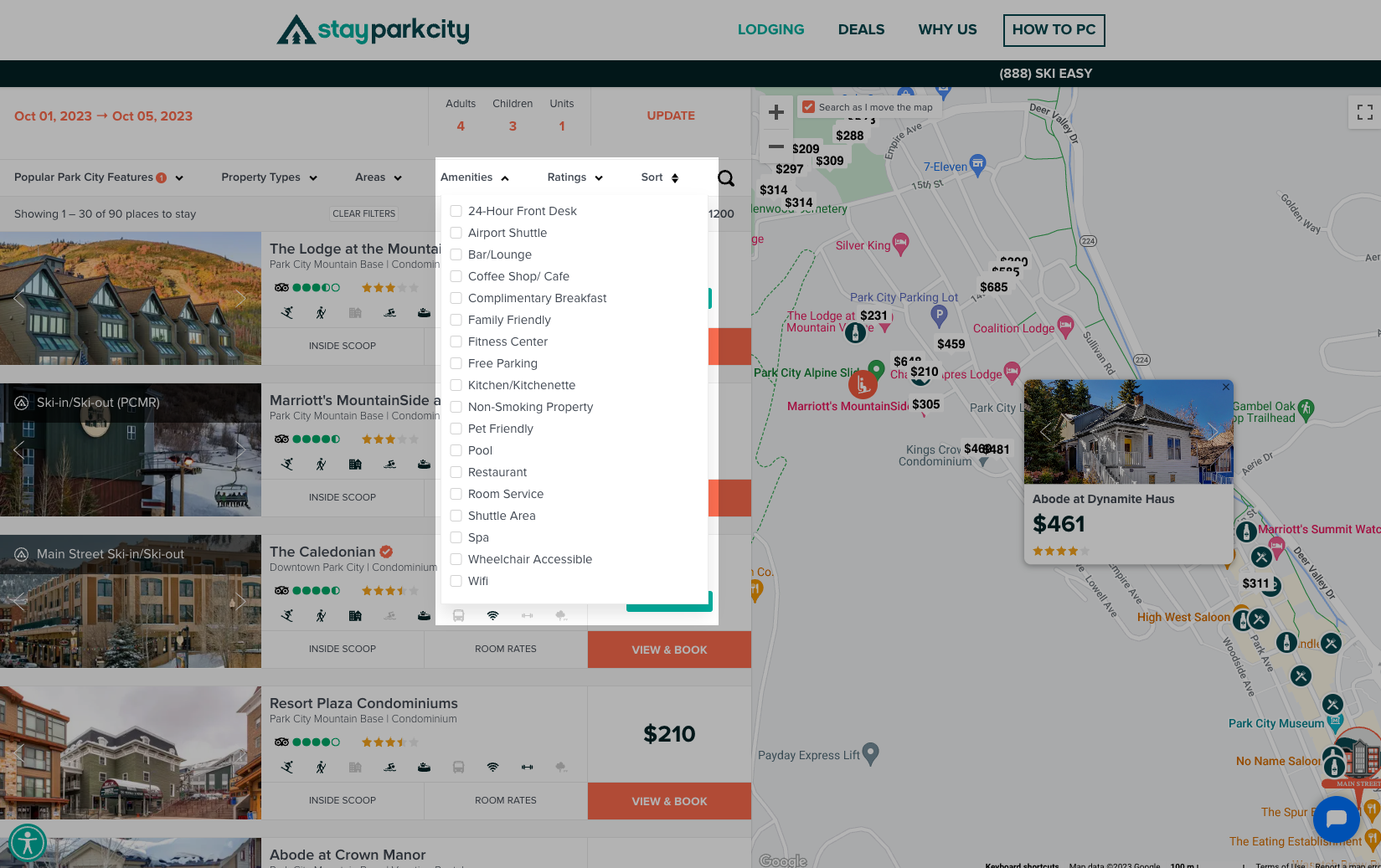Property Attributes
Property attributes allow travelers to filter results based on certain criteria. Each property attribute in Ripe is designed to be used in a specific way to create the best user experience. By understanding the intent and definition one below you will create the best user experience.
Local Highlights
- Purpose: To help travelers connect with key experiences and local flavors that make a destination unique, allowing them to filter lodging options based on what matters most to their travel goals.
- Definition: Geographic or cultural landmarks and attractions that define a destination and significantly enhance its appeal. Properties are categorized by their proximity to or direct association with these highlights.
- Examples: Convention center, arts and culture districts, ski in/ski out locations, beachfront or waterfront access, historic districts, mountain or trail access, sports venues, culinary hotspots, shopping districts, and entertainment hubs.
You can rename the field if you want to call it something else

Property Type
- Purpose: To categorize accommodations by their fundamental structure and service model, allowing travelers to filter their search based on the type of experience they’re seeking, whether it's a full-service hotel stay, a home-like setting, or a unique and adventurous option like a yurt or campsite.
- Definition: The classification of lodging based on the structure, style, and primary function of the accommodation. Each property is categorized under a single property type, defining its fundamental nature and helping travelers easily identify the kind of experience they can expect.
- Examples
- Hotel: Traditional lodging with private rooms, on-site services, and amenities like room service, concierge, and often restaurants or bars.
- Motel: Typically roadside accommodations with direct access to rooms from parking areas, offering basic amenities and convenient for travelers on the move.
- House: Entire residential properties available for stays, offering private, fully furnished accommodations ideal for families or groups.
- Condominium: Self-contained units within a larger complex, often with kitchen facilities, living areas, and more space, suitable for extended stays or families seeking a home-like experience.
- Bed & Breakfast: Smaller, often independently owned properties offering a more personalized stay with breakfast included, typically situated in charming or historic buildings.
- Campground: Outdoor lodging options that range from basic tent sites to more equipped RV spots or cabins, appealing to travelers looking for a nature-centric, rustic experience.
Area
- Purpose: To assist travelers in navigating a city by its key zones, making it easier to find accommodations within areas that align with their itinerary, whether for business, leisure, proximity to family or events, or cultural exploration. By default, you should reference your primary website and match the areas you already communicate about your destination. Not only is this faster but it provides consistency for the traveler who is consuming your site content.
- Definition: A distinct geographic or cultural section within a city that groups properties based on their location, often characterized by a common vibe, purpose, or set of attractions. This allows users to explore lodging options within specific urban or suburban segments.
- Examples: Tribeca in New York City, Old Town in Alexandria, Fisherman's Wharf in San Francisco, University Districts (e.g., University of Texas area), Financial Districts, Downtown, Historic Quarters, or neighborhoods known for nightlife, shopping, or dining.
Amenities
- Purpose: To cater to specific guest needs and preferences, enabling travelers to select properties that offer the amenities they value most during their stay.
- Definition: Specific services, facilities, or features offered by a property that enhance the guest experience by providing added convenience, comfort, or luxury.
- Examples: Bar/lounge, free parking, electric vehicle (EV) charging stations, spa and wellness centers, swimming pools, airport or local shuttles, complimentary breakfast, pet-friendly accommodations, fitness centers, and high-speed Wi-Fi.

Guest Reviews
- Purpose: User reviews provide authentic, real-world insights from fellow travelers, often serving as the most persuasive attribute when selecting accommodations. They help potential guests anticipate the strengths and weaknesses of a property, making the reviews an invaluable tool for transparency and trust in the booking process.
- Definition: User-generated feedback reflecting the personal experiences of travelers who have stayed at the property. Reviews typically include star ratings, written feedback, and often photos, providing a candid insight into what guests can expect. These reviews are a critical factor in a traveler’s decision-making process, often outweighing official ratings or property descriptions.
- Examples of Common Review Factors:
- Cleanliness: How well-maintained and clean the rooms and facilities are.
- Service: The friendliness, helpfulness, and professionalism of the staff.
- Location: Proximity to local highlights, attractions, and conveniences.
- Value: Perceived value for money considering the cost versus the quality of experience.
- Amenities: The quality and condition of amenities like Wi-Fi, pools, and dining options.
Hotel Star Rating
Only shown when available for hotels. Not applicable or used for private condos or homes.
Purpose: To provide a quick, recognizable measure of a property's service and quality, assisting travelers in making accommodation choices that align with their preferences for comfort, amenities, and service level.
Definition: A standardized rating system that categorizes hotels from 1 to 5 stars based on the quality of their facilities, services, and overall guest experience. This rating helps travelers set their expectations and make informed choices. Ratings are sourced from official platforms like Expedia, Google, and other industry-standard sources.
1 Star: Basic accommodations offering essential amenities like a bed and bathroom. Typically, these are budget options with limited or no extra services or facilities. Cleanliness and safety standards are met, but the focus is on providing a no-frills lodging experience.
2 Stars: Slightly upgraded from 1-star properties, these may include basic facilities such as a TV, telephone, and often a small, in-room workspace. Service is minimal, but the accommodations are comfortable and functional, typically suited for budget-conscious travelers.
3 Stars: Mid-range accommodations that offer a balanced mix of comfort, service, and amenities. Hotels often provide on-site dining, a fitness center, or a business area, with room amenities like a coffee maker and basic toiletries. Service quality and décor are typically enhanced compared to lower-rated properties.
4 Stars: Upscale accommodations with a high level of service and a broad range of amenities. These hotels often feature premium bedding, multiple dining options, pools, spas, fitness centers, and concierge services. Rooms are more spacious and well-appointed, catering to both business and leisure travelers seeking a higher level of comfort and service.
5 Stars: Luxury accommodations offering the highest level of service, facilities, and attention to detail. These properties often include personalized services, fine dining, luxurious spas, expansive rooms, high-end décor, and amenities like butler service or chauffeur-driven transfers. The experience is marked by exceptional standards in hospitality, design, and guest comfort.
Updated 2 months ago